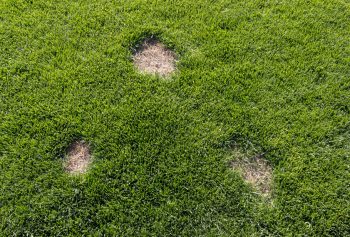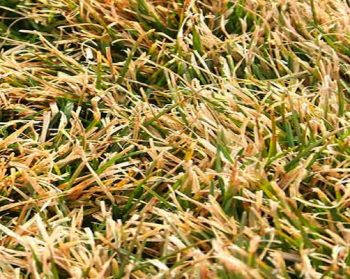Having a level lawn is a goal for many homeowners, as it not only enhances the overall aesthetics of the property but also provides a smoother surface for activities and mowing. However, due to various factors such as settling, erosion, or even improper installation, lawns can develop uneven spots over time. Find out what you need to know about lawn leveling for the growing season today.
In this blog post, we’ll delve into when it’s appropriate to level a lawn and the essential steps to achieve a beautifully even surface.
Identifying the Need for Leveling
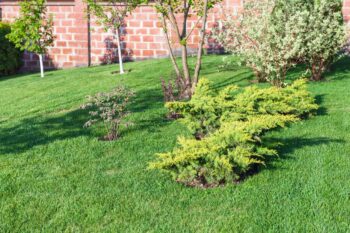
Unevenness: Walk across your lawn and observe any noticeable uneven or sunken areas. These low spots can be a result of soil settling, poor drainage, or erosion.
Water Ponding: If you notice water pooling or collecting in particular areas after rainfall or irrigation, it indicates poor drainage and a need for leveling.
Difficulty in Mowing: If your mower frequently scalps or leaves patches of uncut grass due to uneven ground, it’s a clear sign that your lawn needs leveling. Check out our lawn mowing service page to find out how we can help with mowing.
Determining the Right Time to Level
Early Spring or Late Fall: It is best to level your lawn during periods when grass growth is slower, such as early spring before it enters its active growth phase or late fall after the growth has slowed down. This timing allows the grass to recover more quickly from any disruption caused during the leveling process.
Stable Weather Conditions: Choose to level your lawn when the weather is expected to be dry for the following few days. This ensures that the soil is workable and allows for better compaction during the leveling process.
Before Installing Sod or Re-seeding: If you intend to install new sod or re-seed your lawn, it is crucial to level the surface beforehand, ensuring optimal contact between the new grass and the soil for healthy growth. If you need help with sod installation, contact us.

Materials that can be Used to Level a Lawn
When it comes to leveling a lawn, different materials can be used to achieve the desired results. Some of the most common materials used for leveling a lawn include topsoil, sand, compost, and leveling mix. Topsoil is often used to raise the low spots, while sand is ideal for filling in sunken spots or softening clayey soils.
Compost is an excellent option if you want to enrich the soil while leveling your lawn, and leveling mix is a combination of sand, soil, and compost that provides balanced nutrients and drainage. Whatever material you choose, ensure it’s of good quality and suited to your soil type for the best results.
Learn how to make your own compost bin.
Steps to Level a Lawn
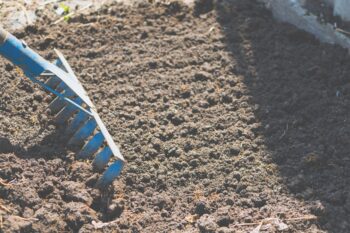
Remove debris: Clear the lawn of any leaves, rocks, or tree roots that may obstruct the leveling process.
Identify low spots: Use a long, straight board or a level to identify the areas needing attention. The board will lay flat over the high spots and reveal the lower areas that require filling.
Fill low spots: Add a suitable fill material, such as topsoil or a leveling mix, to the low spots until they are slightly higher than the surrounding ground. Avoid using clayey soils that can retain water, leading to drainage issues.
Rake and level: Use a rake or leveling tool to distribute the fill material evenly across the low spots. Work the material in a back-and-forth motion to achieve a smooth and level surface.
Compact the soil: Rent or use a lawn roller to compact the soil gently. This step ensures proper contact between the fill material and the existing soil.
Re-seed or lay sod: If needed, spread grass seed or install new sod in the newly leveled areas according to the manufacturer’s instructions.
Water and maintain: Keep the newly leveled areas consistently moist during the germination period if you’ve seeded the lawn. Follow recommended watering and maintenance practices for new sod, including keeping it well irrigated during the initial establishment phase. Consider investing in a moisture management service to rejuvenate your lawn.
Read this article published by Texas A&M University to find out, “How to Get a Beautiful Lawn.”
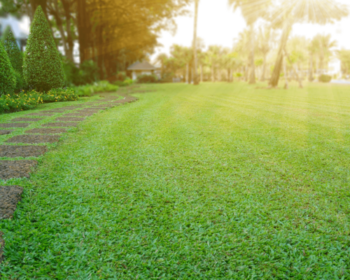
Conclusion
Achieving a level lawn not only improves its appearance but also provides a more enjoyable outdoor space. By identifying the signs that indicate your lawn needs leveling and following the appropriate steps during the right time, you can address unevenness effectively.
A level lawn ensures a smoother mowing experience, prevents water ponding, and promotes healthy grass growth. So, plan your leveling project, show your lawn some care, and enjoy the results of a well-leveled and beautiful lawn year-round.



